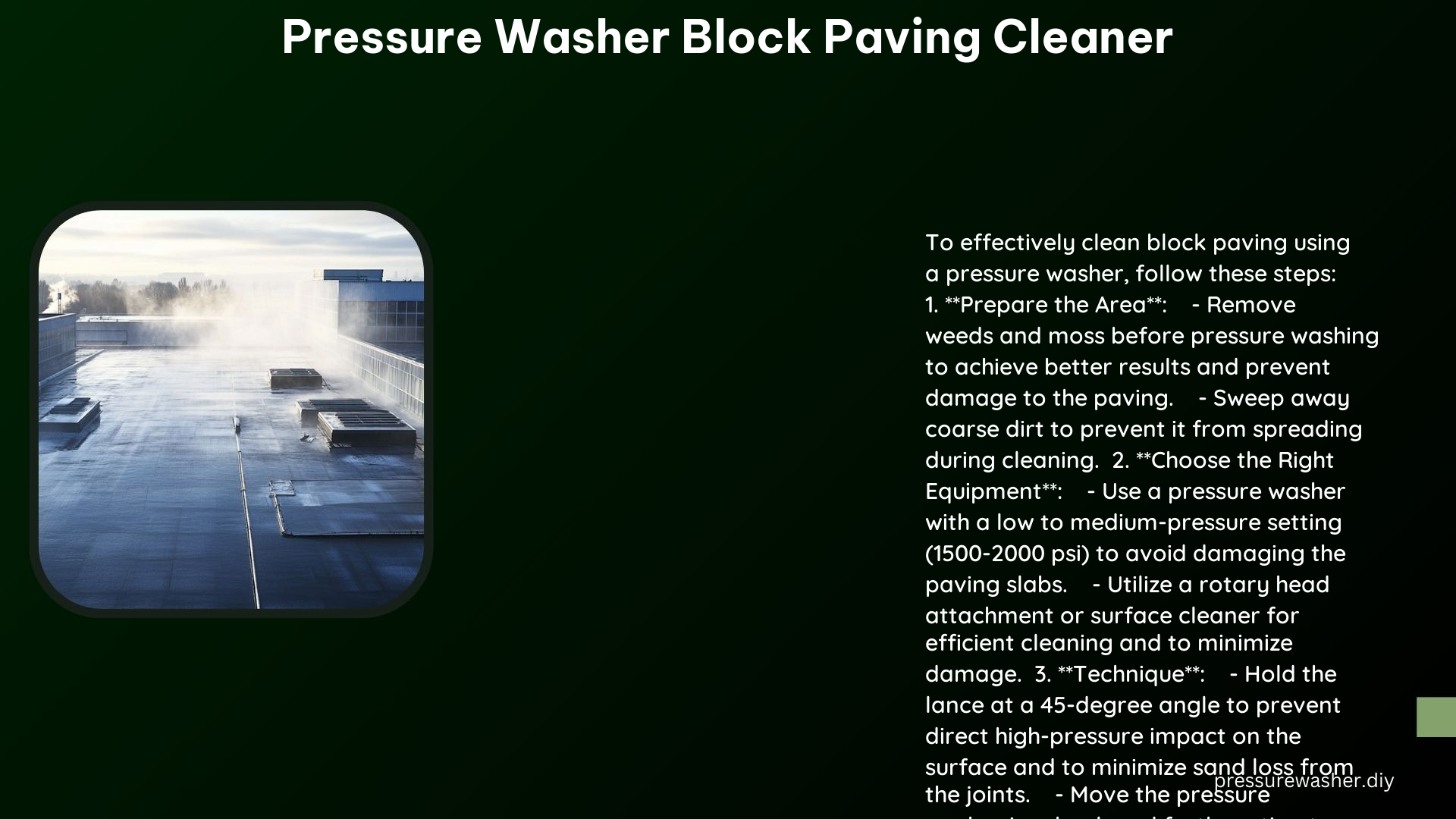Pressure washers are a highly effective tool for cleaning block paving, removing stubborn dirt, moss, and weeds from the surface and joints. However, it is crucial to use the right techniques and equipment to avoid damaging the paving stones. This comprehensive guide will provide you with the necessary information to clean your block paving safely and efficiently using a pressure washer.
Preparing the Surface
Before using a pressure washer, it is essential to remove any weeds, moss, and debris from the joints and surface of the paving stones. This can be done using a stiff-bristled brush or a grass strimmer. Thoroughly clearing the surface ensures that the dirt and debris do not spread during the cleaning process, leading to a more effective and thorough clean.
Choosing the Right Equipment

Pressure Washer
When selecting a pressure washer for cleaning block paving, it is recommended to choose a model with a low to medium-pressure setting, typically ranging from 1500 to 2000 psi. Higher pressure settings can potentially damage the paving stones, causing cracks or chipping.
Attachments
To enhance the cleaning efficiency and safety, it is advisable to use specialized attachments with your pressure washer. A surface cleaner or a dirt blaster lance attachment can help distribute the water pressure evenly, preventing direct, high-pressure impact on the surface. These attachments also allow for a more thorough and consistent clean, especially in hard-to-reach areas.
Techniques for Effective Cleaning
-
Hold the nozzle at an angle: When using the pressure washer, hold the lance at a 45-degree angle to the surface. This helps to lessen the force of the high-pressure water jet on the joints and blocks, reducing the risk of damage.
-
Use a back and forth motion: Move the pressure washer in a smooth, back and forth motion, rather than up and down. This technique helps to prevent streaking and ensures that all areas of the paving are thoroughly cleaned.
-
Work with the slope: Always work with the slope of the paving, allowing the dirty water to run off and not spread over the already cleaned surface. This helps to maintain a clean and consistent appearance.
-
Use a surface cleaner: A surface cleaner attachment with a rinsing function is an excellent tool for thoroughly removing green deposits, moss, and dirt, especially in hard-to-reach corners and on the edges of the paving.
Safety Precautions
Protective Clothing
When using a pressure washer, it is essential to wear appropriate protective clothing, including goggles, to safeguard yourself from the high-pressure water jet and any debris that may be dislodged during the cleaning process.
Avoid Over-Cleaning
It is important to note that pressure washing block paving too frequently can cause permanent damage to the joints and lead to color loss on the paving stones. It is generally recommended to pressure wash block paving once a year, or as needed, to maintain its appearance and structural integrity.
Additional Tips
Brush Removal of Weeds
Before using a pressure washer, it is advisable to use a stiff-bristled brush to remove any weeds, moss, or debris from the paving bricks. This ensures that the joint sand remains firmly compacted between the blocks, maintaining the structural stability of the driveway or patio.
Avoid High-Pressure Settings
High-pressure settings on the pressure washer can dislodge the sand between the blocks, potentially causing damage to the overall structure of the paving. It is crucial to use the recommended pressure range of 1500-2000 psi to avoid this issue.
Chemical Cleaner Pre-Treatment
For areas with heavy moss and weed growth, consider using a chemical cleaner, such as sodium hypochlorite, to pre-treat the surface before pressure washing. This can help to loosen and break down the stubborn organic matter, making the pressure washing process more effective.
Technical Specifications
- Pressure: 1500-2000 psi
- Water flow: 2.5 gallons per minute (average pressure washer)
- Attachments: Surface cleaner, dirt blaster lance, rotary head attachment
References
- Kärcher International. (n.d.). How to clean pavers. Retrieved from https://www.kaercher.com/int/home-garden/know-how/cleaning-pavers.html
- Big Ted’s Home and Garden. (2024, April 2). Pressure Washing Block Paving using a Karcher K4 Pressure Washer. Retrieved from https://www.youtube.com/watch?v=hcnjFn0c0qA
- Landscaping Cost. (2024, June 14). How to Jet Wash Block Paving Correctly [The Ultimate Guide]. Retrieved from https://landscapingcost.co.uk/how-to-jet-wash-block-paving/
- Dirty Drive-Away. (2021, October 11). Pressure Washing Block Paving – Total Transformation. Retrieved from https://www.youtube.com/watch?v=h8KbOzn1RHQ
- Total Pressure Cleaning. (n.d.). The Do’s & Don’ts of Pressure Washing Your Block Paving. Retrieved from https://www.totalpressurecleaning.co.uk/the-dos-donts-of-pressure-washing-your-block-paving/
